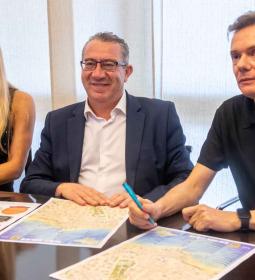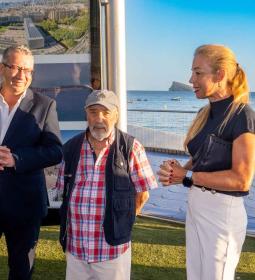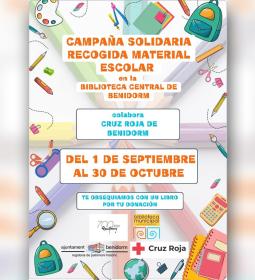The exhibition opens this Thursday, July 3, and includes a hundred images from this pioneer in photojournalism and fashion photography in our country
Boca del Calvari Museum hosts the exhibition 'Moda a pie de calle' by the photographer Joana Biarnés

For the next few months, the Boca del Calvari Museum will host the exhibition "Fashion on the Street," by renowned photographer Joana Biarnés (1935-2018), considered the first female photojournalist in Spain, whose work is curated and disseminated by the Photographic Social Vision Foundation. The exhibition, promoted by the Department of Historical and Cultural Heritage of the Benidorm City Council in collaboration with the foundation, will open this Thursday, July 3, at 7:30 p.m. and can be visited at this municipal museum until October 19.
The Councilor for Historical and Cultural Heritage, Ana Pellicer, along with the Mayor of the city, Toni Pérez, invited citizens and visitors to "visit this new exhibition we are bringing to the Boca del Calvari Museum, the work of this woman who was a pioneer in photojournalism and also in fashion photography, both in Spain and internationally, and who knew how to capture the essence of her time like no one else."
Joana Biarnés is now recognised as an essential figure in the history of Spanish photography, whose work also highlights her perspective on the world of fashion. Her influence in this sector is demonstrated in this exhibition, which includes nearly 100 photographs that present the evolution of fashion and society during a time of momentous change, from the late 1950s to the early 1970s, between Barcelona and Madrid.
Biarnés chronicled the radical evolution that took place in clothing, from the classicism of haute couture to the informality of ready-to-wear, and the lack of conventionalism emerging from late 1960s London and the hippie movement.
Biarnés' relationship with fashion
Joana Biarnés had been making her way as a photojournalist for a few years when she entered the fashion world. Her involvement in the industry began in 1959 when Pilar de Ávia, director of the magazine La Moda en España, published in Madrid, asked her to collaborate on fashion articles, especially those featuring Barcelona haute couture, which was then the most important in Spain. The close friendship between the two led to the photographer's contact with two of the leading representatives of haute couture established in Barcelona and Madrid: Pedro Rodríguez and Asunción Bastida, with whom she worked regularly between 1959 and 1962.
In 1963, she began working as a photojournalist for the newspaper Pueblo, and Joana settled in Madrid, beginning a period that would last almost ten years and give rise to the best of her photographic output. While her journalistic work was excellent, Joana felt much more creative in her fashion editorials for a weekly supplement of Pueblo magazine, because she played a much more active role in them and discovered the pleasure of shooting images she herself had created and inspired. The photographer chose the styles, themes, locations, models, and sometimes even provided her own accessories. Joana loved being fashionable and enjoyed leafing through European magazines, which influenced her way of dressing and looking, and which she had access to thanks to spending time in France with the family of her husband, journalist Jean Michel Bamberger.
This fertile period opened the doors for her to lead Madrid designers such as Lino, Vargas y Ochagavía, Marbel Jr., Herrera y Ollero, and most notably, Elio Berhanyer, as well as Antonio Nieto, Miguel Rueda, and Juanjo Rocafort, as well as furriers José Luis, Miguel Marinero, Herrero y Rodero, Cirilo Fernández, and Villaroy, as well as accessories brands such as Cottet opticians, for which she served as the face of many advertising campaigns.
Biarnés became a regular chronicler of the society and glamour of the Spanish capital. She frequently photographed figures with whom she maintained a close friendship and who, in some way, were also connected to the fashion of their time. Lucía Bosé, Karina, Natalia Figueroa, and her husband Raphael were some of them. Biarnés's opinion was key in the choice of the André Courrèges dress with which Massiel performed the popular song La, la, la and won the 1968 Eurovision Song Contest, thus helping to create one of the Spanish icons of the era.
A unique look
Joana treated fashion with the same closeness and sincerity as the other subjects she documented, and this is one of her main contributions to the genre. In this field, so prone to fantasy and sophistication, she often placed models naturally on the street, without seeking lavish settings, and she captured the essence of her time like no one else.
At that time, photographing a model in the middle of the street in Madrid was provocative. And in her desire to document the first signs of openness in this country, Biarnés also captured the reactions of astonished men and open-mouthed women in her fashion photographs. It was her way of promoting a certain relaxation in society and the perception of a panorama to which she visually contributed a good dose of joy, mischief, and freshness.
The exhibition, which compiles the best images of her fashion work, was a long-cherished dream of its curator, art and fashion historian and critic Josep Casamartina i Parassols, and of Joana herself, who sadly passed away in 2018 without being able to enjoy the success she had previously enjoyed at the Tinglado 2 space of the Tarragona City Council; the Sala Muncunill of Terrassa City Council, Sala Canal de Isabel II of the Community of Madrid; and the Provincial Museum of Teruel.
Now, the entire collection can be seen in Boca del Calvari Museum in Benidorm, thanks to Benidorm City Council and the Photographic Social Vision Foundation. An organisation that defends the social value of documentary photography and safeguards and disseminates the Joana Biarnés Archive.




